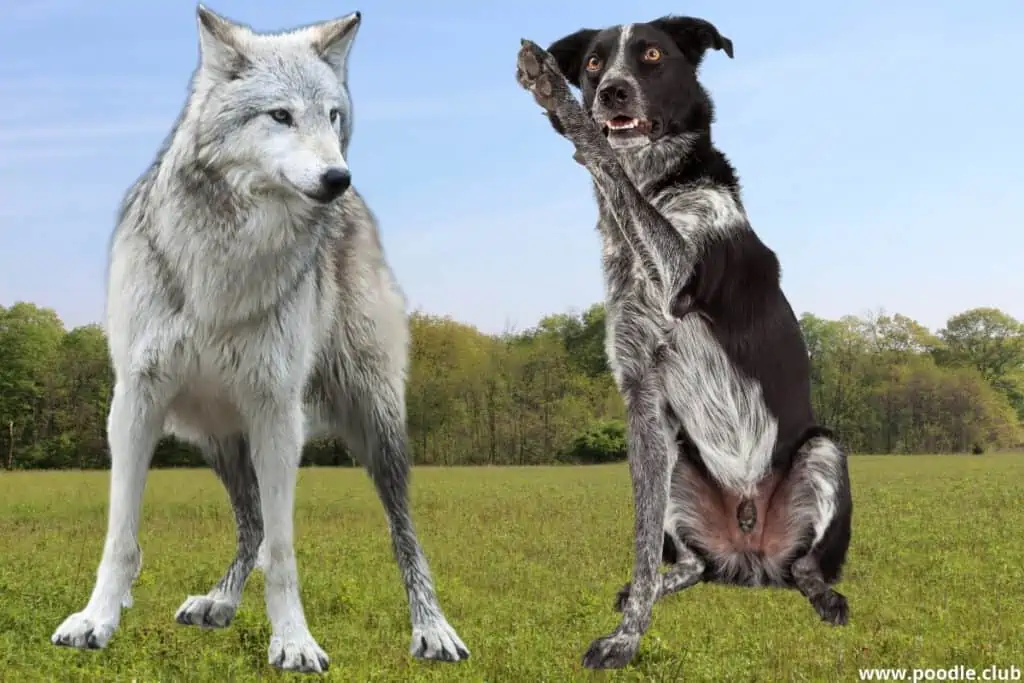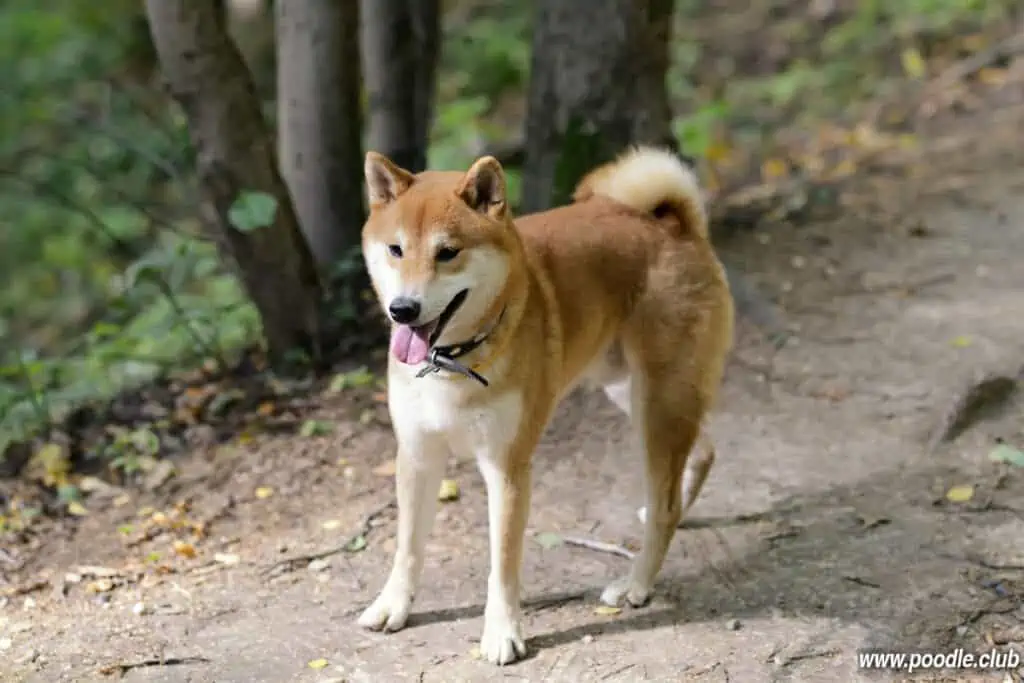What Dog Is Closest To a Wolf? (5 Breeds with Photos)
It’s no secret that dogs and wolves are closely related. In fact, all domesticated dogs are descendants of the gray wolf. However, some dogs are more closely genetically related to the wolf than others.
For example, the Siberian Husky is thought to be one of the most closely related dog breeds to the wolf, while the Lhasa Apso is less closely related. Different dog breeds have been selectively bred for different traits over time. The result is a wide range of genetic diversity within the dog family.

However, no matter how closely related a dog is to the wolf, it is still a domesticated animal and, therefore, significantly different from its wild cousins.
Though all dogs are close relatives to the wolf, some breeds are more closely genetically related than others. Below you will find the top 5 dog breeds most closely related to the wolf.
Why are Some Breeds More Closely Related to the Wolf?
Dr. Robert K. Wayne (UCLA) is a molecular geneticist and canid biologist who has dedicated his life to studying the relationships between different species of canids, including wolves, dogs, and coyotes.

He has discovered that today’s dogs’ DNA is only distinguishable from grey wolves by 0.2 percent. When comparing DNA sequences, the difference between them is pretty small, considering that coyotes are usually considered the wolf’s closest relatives and have a 4 percent variation in their DNA. In this sense, dogs are more similar to wolves than coyotes.
Consequently, it is no surprise that many dogs exhibit behaviors more closely related to wolves than other dog breeds. They show a wide range of behaviors, from strictly predatory to those that appear to be almost exclusively social.
PuppySpot is a reputable dog marketplace where you can browse and find compatible puppies right from the comfort of your home. They have placed over 200,000 puppies into homes in the US!
For example, Border Collies are known for their herding abilities, while Basset Hounds are relatively easygoing and laid-back. However, both breeds share a common ancestor in the Grey Wolf. As Dr. Wayne explains, “The Border Collie is bred for its unique herding instinct.
However, this behavior must have been present in the ancestral wolf population from which all dog breeds descended.”
In other words, herding is a behavior that was likely present in the Grey Wolf and has been passed down through the generations to the Border Collie.
So, if all dogs descended from the Grey Wolf, why are some breeds more closely related to the wolf than others? The answer lies in something called selective breeding.
Selective Breeding
Selective breeding is the process of selectively choosing which animals will reproduce in order to perpetuate a certain desired trait. For example, if a farmer wanted to breed a cow that produced more milk, they would choose the cow that produced the most milk and mate it with another cow that also produced a lot of milk. Over time, this process would result in a herd of cows that produce more milk than the average cow.
Similarly, if a breeder wanted to create a dog that was more closely related to the wolf, they would choose the dogs that exhibited behavior and physical traits that were most similar to the wolf and mate them with other dogs that also exhibited these traits.
As Dr. Wayne explains, “By breeding the dogs that were more wolf-like in appearance and behavior, the breeders were inadvertently selecting for genes that made the dogs more genetically similar to wolves.”
Over time, this process of selective breeding has resulted in several dog breeds that are more closely related to the wolf than other breeds.
The 5 Dog Breeds Most Closely Related to the Wolf
1. Shiba Inu
The Shiba Inu is a Japanese breed of dog closely related to the wolf. In fact, the Shiba Inu is one of the most ancient dog breeds, and its DNA is very similar to that of the grey wolf.

However, there are some key differences between the two animals. For one, the Shiba Inu is much smaller than the average wolf, weighing in at only about 20 pounds. Additionally, the Shiba Inu has a distinctive curly tail, whereas wolves have straight tails.
Finally, while wolves are primarily grey or brown, Shiba Inus can be red, black, or tan. Despite these differences, it is clear that the Shiba Inu shares a close connection to the wolf.
2. Chow Chow
The Chow Chow is a dog breed often described as having a “stuffy” personality. They are independent and aloof, and they are not typically known for being particularly friendly or social.

However, what many people don’t know is that the Chow Chow is actually closely related to the gray wolf. In fact, DNA analysis has shown that the Chow Chow is one of the most ancient dog breeds in existence, and they are thought to be directly descended from the wolves that were first domesticated by humans.
This is reflected in their appearance, as they share many physical characteristics with wolves, including a thick double coat, a broad head, and a tail that curls over their back. While they may not act like it, the Chow Chow is definitely a breed with a wild history.
3. Akita Inu
The Akita Inu is a Japanese dog breed closely related to the gray wolf. In fact, the Akita is one of the most genetically close relatives of the gray wolf out of all domesticated dog breeds. This is likely because the Akita’s lineage can be traced back to ancient Japan, where it was bred for hunting.

They are large dogs, with males standing up to 28 inches tall and weighing up to 130 pounds. Akitas are considered to be a Spitz breed, which means they share certain physical characteristics with other Spitz-type dogs, such as Samoyeds and Huskies.
One of the most notable things about Akitas is their thick coats, which can be either short or long and come in various colors, including white, brindle, and red. Akitas are also known for their triangular-shaped heads and small, pointed ears.
The Akita has a reputation for being independent and loyal, and it is often used as a guard dog or hunting companion.
4. Alaskan Malamute
The Alaskan Malamute is a member of the spitz family of dogs, including other Arctic breeds such as the Samoyed and the Siberian Husky. Like all spitz dogs, the Malamute has a pointed muzzle, erect ears, and thick fur coat.

However, there are several ways in which the Malamute differs from its wild cousin, the gray wolf. For one thing, the Malamute is significantly smaller than the average wolf, weighing in at around 100 pounds compared to the wolf’s 150-pound average.
Additionally, while wolves typically have gray or white fur, the Malamute can be any color, from black to red to silver.
Finally, while wolves are typically shy around humans, the Malamute is known for its friendly and outgoing personality.
However, despite these differences, DNA testing has shown that the Alaskan Malamute is still closely related to the gray wolf, sharing over 99% of its genetic code. This close connection is likely because both animals are native to the cold climates of North America.
5. Siberian Husky
While the Siberian Husky may look like a wolf, it is actually a member of the dog family. However, the Husky does have some wolf-like features, including a thick coat of fur and pointy ears.

The Siberian Husky is also closely related to the gray wolf. Their genetics are so similar that they can successfully interbreed. The history of the Husky is also closely linked to the gray wolf.
The breed originated in Siberia, and it is thought that early Huskies were bred from gray wolves. As a result of this close connection, the Siberian Husky is sometimes referred to as a “wolf dog.”
For example, both dogs have a dense double coat protecting them from cold weather. They also share a similar appearance, with elongated muzzles and erect ears.
However, there are some key differences between the two breeds. Huskies are typically smaller than wolves, and they have a more diverse range of coat colors. In addition, huskies generally have a friendly disposition, while wolves are more aggressive.
The Siberian Husky is still very closely related to the gray wolf despite these differences.
Honorable (Surprising) Mentions
Shih Tzu
DNA studies have shown that the Shih Tzu shares a common ancestor with the gray wolf, making them one of the most genetically diverse dog breeds in the world.

Pekingese
DNA analysis shows that the Pekingese shares a common ancestry with other toy breeds, including the Shih Tzu and the Maltese.

Lhasa Apso
The Lhasa Apso is closely related to the gray wolf, sharing many of the same physical and behavioral characteristics.

Final Thoughts
Just as there are many different types of humans, there are also many different types of dogs. Each breed has its own unique set of characteristics, and while some may be more closely related to the gray wolf than others, all dogs share a common ancestor.
The top five dogs most closely related to the gray wolf, according to research, are the Shiba Inu, the Alaskan Malamute, the Siberian Husky, the Chow Chow, and the Akita Inu. While each of these breeds has its own distinct appearance and personality, they all share a common bond – their wild ancestry.
So what dog is closest to a wolf? If asked answer one of the five breeds listed above. But be sure to tell whoever is asking that dogs are so far removed from wolves despite sharing the same DNA.
So if you’re ever feeling a little wild yourself, be sure to spend some time with your canine companion. They just might remind you of your own primal roots.


![Toy vs Miniature Poodle [Comparison + Photos]](https://poodle.club/wp-content/uploads/2022/12/toy-vs-mini-poodle-768x512.webp)




![Are Poodles Fussy Eaters? [5 Fixes]](https://poodle.club/wp-content/uploads/2022/08/are-poodles-fussy-eaters-768x512.webp)